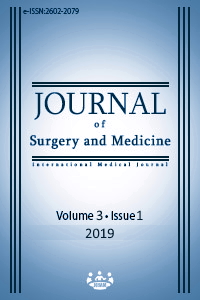Is ultrasound guided syringe-free method more efficient for saphenous vein catheterization? A prospective randomized controlled study
Keywords:
Syringe-free, Ultrasound guided, CatheterizationAbstract
Aim: Syringe-free is a novel technique without making blood aspiration with a syringe and by pushing forward the guide wire after verifying that the needle is inside the vein. In this study, we aimed to compare the vein intervention time between the ultrasound-guided syringe-free technique and the ultrasound-guided technique requiring syringe and aspiration procedures (classic technique), and also the success and complication rates of the first application.
Methods: A prospective randomized controlled study was designed to compare ultrasound-guided syringe-free and ultrasound-guided classic technique in patients performed saphenous vein catheterization between June 2018 and September 2018. Demographic data, the period passed until a successful catheterization, the time for the needle to enter to the vein and the needle intervention number and complications are recorded.
Results: 75 patient were enrolled in the study. There were no differences between demographical data in the patients (p>0.05). Vein puncture time were similar in each group (p=0.750). In the ultrasound-guided syringe-free group the catheterization time is determined to be significantly shorter (p=0.003). In the syringe-free method, it is determined that the successful catheterization number is higher at first try, but the difference is not determined to be significant (p=0.370). In both groups, central venous catheter-related complications were not observed during or after the procedure.
Conclusion: In conclusion, an ultrasound-guided syringe-free approach can a decrease the duration of saphenous vein catheterization and allows the operator to perform the whole procedure with ultrasound guidance without interruptions. This method can be used as an advantageous and practical method for experienced operators.
Downloads
References
Mazzaccaro DP, Stegher S, Occhiuto MT, Muzzarelli L, Malacrida G, Nano G. Varicose veins: new trends in treatment in a Vascular Surgery Unit. Annali italiani di chirurgia. 2016;87:166-71.
Jones T, Stea N, Stolz U, Adhikari S. Ultrasound evaluation of saphenous vein for peripheral intravenous cannulation in adults. J Vasc Access. 2015;16:418-21.
Baeshko A, Shestak N, Korytko S. Results of Ultrasound-Guided Foam Sclerotherapy of the Great Saphenous Vein With New Parameters of the Technique. Vasc Endovascular Surg. 2016;50:528-33.
Biemans AA, Van Den Bos RR, Nijsten T. Endovenous therapies of varicose veins: indications, procedures, efficacy and safety. Giornale italiano di dermatologia e venereologia: organo ufficiale, Societa italiana di dermatologia e sifilografia. 2010;145 :161-73.
DiLisio R, Mittnacht AJC. The “medial oblique” approach to ultrasound-guided central venous cannulation – maximize the view, minimize the risk. J Cardiothoracic Vasc Anesth. 2012;26: 982– 4.
Chittoodan S, Breen D, O'Donnell BD, Iohom G. Long versus short axis ultrasound guided approach for internal jugular vein cannulation: a prospective randomised controlled trial. Med Ultrason. 2011;13:21-5.
Stone MB, Moon C, Sutijone D, Blaivas M. Needle tip visualization during ultrasound-guided vascular access: short-axis vs long-axis approach. Am J Emerg Med. 2010; 20:343–7.
Matias F, Semedo E, Carreira C, Pereira P. Ultrasound-guided central venous catheterization - "Syringe-Free" approach]. Rev Bras Anestesiol. 2017;67:314-7.
Gao YB, Yan JH, Ma JM, Liu XN, Dong JY, Sun F, Tang LW, Li J. Effects of long axis in-plane vs short axis out-of-plane techniques during ultrasound-guided vascular access. Am J Emerg Med. 2016;34:778-83.
Tammam TF, El-Shafey EM, Tammam HF. Ultrasound-guided internal jugular vein access: comparison between short axis and long axis techniques. J Kidney Dis Transpl. 2013;24:707–13.
Lv Y, Liu H, Yu P, Wang G, Liu M, Li Y, et al. Evaluating the Long-, Short-, and Oblique-Axis Approaches for Ultrasound-Guided Vascular Access Cannulation. J Ultrasound Med. 2018 Jul 19. doi: 10.1002/jum.14694.
Chao L, Zhi M, Hongjun K, Xin H, Shengmao J, Pan H, et al. Comparison between the long-axis/in-plane and short-axis/out-of-plane approaches for ultrasound-guided vascular catheterization: an updated meta-analysis and trial sequential analysis. Ther Clin Risk Manag. 2018;14:331–40.
Ince I, Arı MA, Sulak MM, Aksoy M. Comparison of transverse short-axis classic and oblique long-axis "Syringe-Free" approaches for internal jugular venous catheterization under ultrasound guidance. Rev Bras Anestesiol. 2018;68:260-5.
Turker G, Kaya FN, Gurbet A, Aksu H, Erdogan C, Atlas A. Internal Jugular Vein Cannulation: An Ultrasound-Guided Technique Versus a Landmark-Guided Technique. Clinics (Sao Paulo) 2009;64:989–92.
Karakitsos D, Labropoulos N, De Groot E, Patrianakos AP, Kouraklis G, Poularas J, et.al. Real-time ultrasound-guided catheterisation of the internal jugular vein: a prospective comparison with the landmark technique in critical care patients. Crit Care. 2006;10: R162.
Agarwal A, Singh DK, Singh AP. Ultrasonography: A novel approach to central venous cannulation. Indian J Crit Care Med. 2009;13:213–6.
Takeshita J, Nishiyama K, Fukumoto A, Shime N. Comparing Combined Short-Axis and Long-Axis Ultrasound-Guided Central Venous Catheterization With Conventional Short-Axis Out-of-Plane Approaches. J Cardiothorac Vasc Anesth. 2018: S1053-0770(18)30610-4. doi: 10.1053/j.jvca.2018.08.005.
Davda D, Schrift D. Posterior Wall Punctures Between Long- and Short-Axis Techniques in a Phantom Intravenous Model. J Ultrasound Med. 2018;37:2891-7.
Downloads
- 754 1750
Published
Issue
Section
How to Cite
License
Copyright (c) 2019 Gözen Öksüz, Erdinç Eroğlu
This work is licensed under a Creative Commons Attribution-NonCommercial-NoDerivatives 4.0 International License.
















